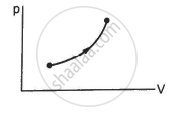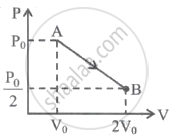Advertisements
Advertisements
प्रश्न
A sample of an ideal gas (γ = 1.5) is compressed adiabatically from a volume of 150 cm3 to 50 cm3. The initial pressure and the initial temperature are 150 kPa and 300 K. Find (a) the number of moles of the gas in the sample (b) the molar heat capacity at constant volume (c) the final pressure and temperature (d) the work done by the gas in the process and (e) the change in internal energy of the gas.
उत्तर
The ideal gas equation is
PV = nRT
Given, P1 = 150 kPa = 150 × 103 Pa
V1 = 150 cm3 = 150 × 10−6 m3
T1= 300 K
(a)
`"n" =("P""V")/("R""T") = 9.036 xx 10^-3`
n = 0.009
(b)
`"C"_"p"/"C"_"v" = gamma , "C"_"p" -"C"_"v" ="R"`
So, `"C"_"v" = "R"/(gamma-1) = 2"R" = 8.3/0.5 = 16.6 "J" "mol" -"K"`
(c) Given,
P1 = 150 kPa = 150 × 103 Pa
P2 = ? V1 = 150 cm3
= 150 × 10−6 m3
γ = 1.5
V2 = 50 cm3 = 50 × 10−6 m3,
T1 = 300 K
T2 = ?
Since the process is adiabatic, using the equation of an adiabatic process,we get
P1V1γ = P2V2γ
⇒ 150 × 103 × (150 × 10−6)γ = P2 × (50 × 10−6)γ
`=> "P"_2 = 150 xx 10^3 xx ((150 xx 10^-6)^1.5)/(50 xx 10 ^-6)^1.5`
P2 = 150000 × (3)1.5
P2 = 779.422 × 103 Pa
P2 = 780 kPa
Again,
P11−γ T1γ = P11−γ T2γ
⇒ (150 × 103)1−1.5 × (330)1.5 = (780 × 103)1−1.5 × T21.5
⇒ T21.5 = (150 × 103)1−1.5 × (300)1.5 × 3001.5
T21.5 = 11849.050
⇒ T2 = (11849.050)1/1.5
T2 = 519.74 = 520 K
d) dQ = dW + dU
Or dW = −dU [ Since dQ = 0 in an adiabatic process]
dW = −nCvdT
dW = −0.009 × 16.6 × (520 − 300)
dW = −0.009 × 16.6 × 220
dW = −32.87 J ≈ −33 J
(e)
dU = nCvdT
dU = 0.009 × 16.6 × 220 ≈ 33 J
APPEARS IN
संबंधित प्रश्न
Estimate the fraction of molecular volume to the actual volume occupied by oxygen gas at STP. Take the diameter of an oxygen molecule to be 3Å.
Consider a mixture of oxygen and hydrogen kept at room temperature. As compared to a hydrogen molecule an oxygen molecule hits the wall
Calculate the mass of 1 cm3 of oxygen kept at STP.
An electric bulb of volume 250 cc was sealed during manufacturing at a pressure of 10−3 mm of mercury at 27°C. Compute the number of air molecules contained in the bulb. Avogadro constant = 6 × 1023 mol−1, density of mercury = 13600 kg m−3 and g = 10 m s−2.
Use R=8.314J K-1 mol-1
The density of an ideal gas is 1.25 × 10−3 g cm−3 at STP. Calculate the molecular weight of the gas.
Use R=8.31J K-1 mol-1
Consider a sample of oxygen at 300 K. Find the average time taken by a molecule to travel a distance equal to the diameter of the earth.
Use R=8.314 JK-1 mol-1
Find the ratio of the mean speed of hydrogen molecules to the mean speed of nitrogen molecules in a sample containing a mixture of the two gases.
Use R = 8.314 JK-1 mol-1
Figure shows a vessel partitioned by a fixed diathermic separator. Different ideal gases are filled in the two parts. The rms speed of the molecules in the left part equals the mean speed of the molecules in the right part. Calculate the ratio of the mass of a molecule in the left part to the mass of a molecule in the right part.

The ratio Cp / Cv for a gas is 1.29. What is the degree of freedom of the molecules of this gas?
Work done by a sample of an ideal gas in a process A is double the work done in another process B. The temperature rises through the same amount in the two processes. If CAand CB be the molar heat capacities for the two processes,
For a solid with a small expansion coefficient,
Let Cv and Cp denote the molar heat capacities of an ideal gas at constant volume and constant pressure respectively. Which of the following is a universal constant?
The figure shows a process on a gas in which pressure and volume both change. The molar heat capacity for this process is C.

The molar heat capacity for the process shown in the figure is

One mole of gas expands obeying the relation as shown in the P-V diagram. The maximum temperature in this process is equal to ______.

